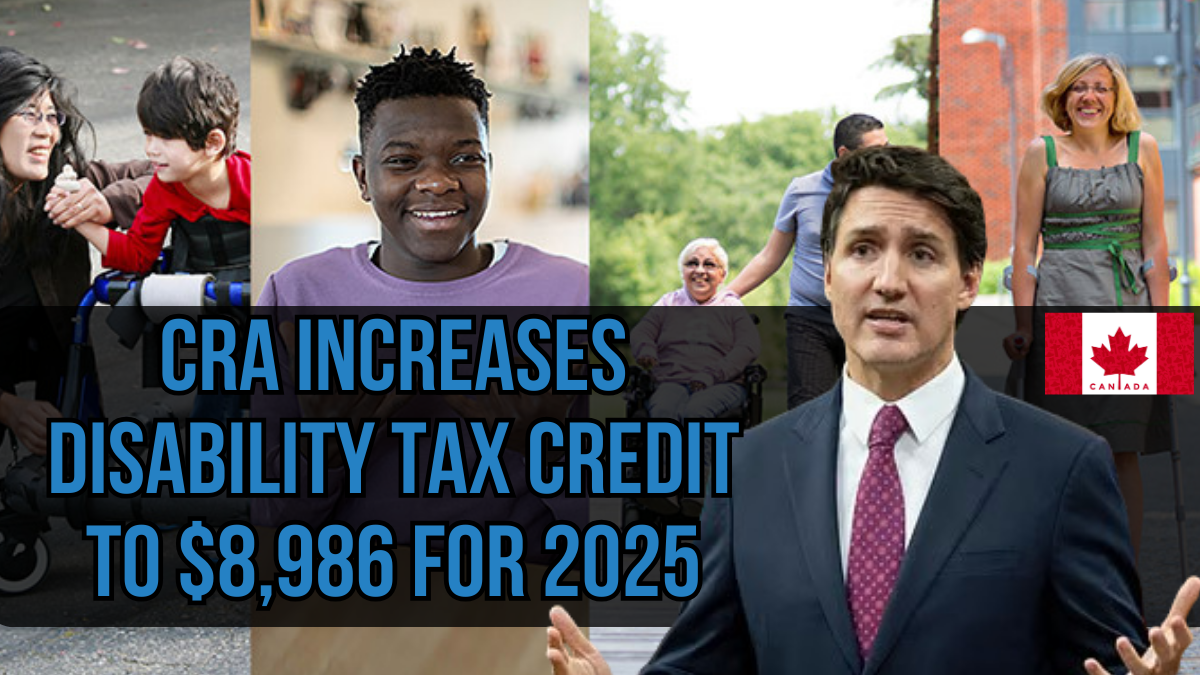The Canada Revenue Agency (CRA) has confirmed a significant boost to the Disability Tax Credit (DTC) for 2025, increasing the maximum possible refund to $8,986. This update aims to provide much-needed financial relief to Canadians living with severe and prolonged disabilities, as well as their supporting family members.

With living expenses, rent, and healthcare costs continuing to rise, the DTC is more than just a tax break — it’s a vital support system that also opens doors to other federal and provincial assistance programs. Below, we cover who qualifies, how to apply, and how to maximize benefits — including retroactive claims for up to 10 years.
Summary Table: Disability Tax Credit to $8,986 for 2025
| Field | Details |
|---|---|
| Scheme Name | Disability Tax Credit (DTC) |
| Authority | Canada Revenue Agency (CRA) |
| Maximum Refund (2025) | Up to $8,986 (Federal + Provincial combined) |
| Eligibility | Canadians with severe and prolonged disabilities certified by a licensed medical professional |
| Application Form | T2201 – Disability Tax Credit Certificate |
| Retroactive Claim Period | Up to 10 years |
| Official Site | Visit CRA Official Page |
What is the Disability Tax Credit (DTC)?
The Disability Tax Credit is a non-refundable tax credit offered by the CRA to help reduce the amount of income tax Canadians with disabilities — or their supporting family members — need to pay. By lowering the tax owed, it provides direct financial relief and can lead to thousands of dollars in refunds.
For 2025, the DTC has been increased to reflect rising costs, making it more valuable than ever.
Who is Eligible for the DTC in 2025?
The DTC is designed for individuals whose daily life is significantly restricted due to a severe and prolonged impairment.
Eligibility Requirements:
- Medical Certification — A licensed medical practitioner (doctor, psychologist, occupational therapist, etc.) must certify the disability on Form T2201.
- Duration — The condition must have lasted, or be expected to last, for at least 12 consecutive months.
- Daily Function Restrictions — You must be markedly restricted in one or more basic activities, such as:
- Walking
- Dressing
- Feeding
- Speaking
- CRA Approval — The CRA must approve your Disability Tax Credit Certificate.
Note: Even if the disabled person has little or no taxable income, a spouse, parent, or guardian can claim the credit on their behalf.
How Much Can You Receive in 2025?
The amount you receive depends on federal and provincial amounts, plus your personal tax situation.
| Component | Federal Amount | Provincial Average | Total Potential Refund |
|---|---|---|---|
| Base DTC | $9,428 | $5,135 | $14,563 |
| Refundable Amount | N/A | N/A | Up to $8,986 |
Some provinces offer additional disability tax credits which can further increase your refund.
How to Apply for the Disability Tax Credit
Applying is straightforward but must be done carefully to avoid delays.
- Download Form T2201 — Available on the CRA website.
- Medical Certification — Have a qualified healthcare professional fill out the required sections.
- Submit Your Application — Either:
- Online via CRA MyAccount, or
- By mailing the completed form to the CRA.
- Await CRA Approval — You will receive a Notice of Determination confirming approval or denial.
Tip: If approved, you can claim the credit for the current year and retroactively for up to 10 years.
Additional Benefits of Qualifying for the DTC
Once approved, you may also qualify for other valuable programs:
- Registered Disability Savings Plan (RDSP) — Long-term savings with government contributions.
- Canada Workers Benefit – Disability Supplement — Extra income support for working Canadians with disabilities.
- Provincial Disability Benefits — Housing, medical, and transportation support.
- Medical Expense Assistance — For travel, mobility aids, or home modifications.
Why the DTC Increase Matters in 2025
With inflation affecting everything from grocery bills to healthcare, this increase:
- Reduces income tax burdens.
- Grants access to other federal/provincial supports.
- Offers financial relief for caregivers.
- Enhances long-term financial independence.
Retroactive Payments – Don’t Miss Out
If you’ve never applied for the DTC before, you might be eligible for retroactive refunds going back up to 10 years. This could mean tens of thousands of dollars in potential back pay.
Steps to Maximize Your Refund:
- Consult your doctor about completing Form T2201.
- Apply promptly online or by mail.
- Check for provincial top-ups.
FAQs: Frequently Asked Questions
Q1: What is the maximum refund from the DTC in 2025?
Ans. A: Up to $8,986, depending on your income, location, and eligibility.
Q2: Can a family member claim the DTC on behalf of someone else?
Ans. A: Yes. A spouse, parent, or guardian can claim it if the person with the disability has little or no taxable income.
Q3: How far back can retroactive claims go?
Ans. A: Up to 10 years, if CRA approves.
Q4: What medical conditions qualify?
Ans. A: Any severe, prolonged impairment that markedly restricts basic daily activities, certified by a licensed medical professional.
Q5: How long does CRA approval take?
Ans. A: Processing can take weeks to months — applying early is advised.
Final Verdict
The 2025 Disability Tax Credit increase to $8,986 is a major financial relief for Canadians with severe, long-term disabilities and their families. It not only reduces taxes but also unlocks access to other federal and provincial benefits, with potential retroactive refunds of up to 10 years — making it essential to review eligibility and apply promptly.
For More Information Click HERE
